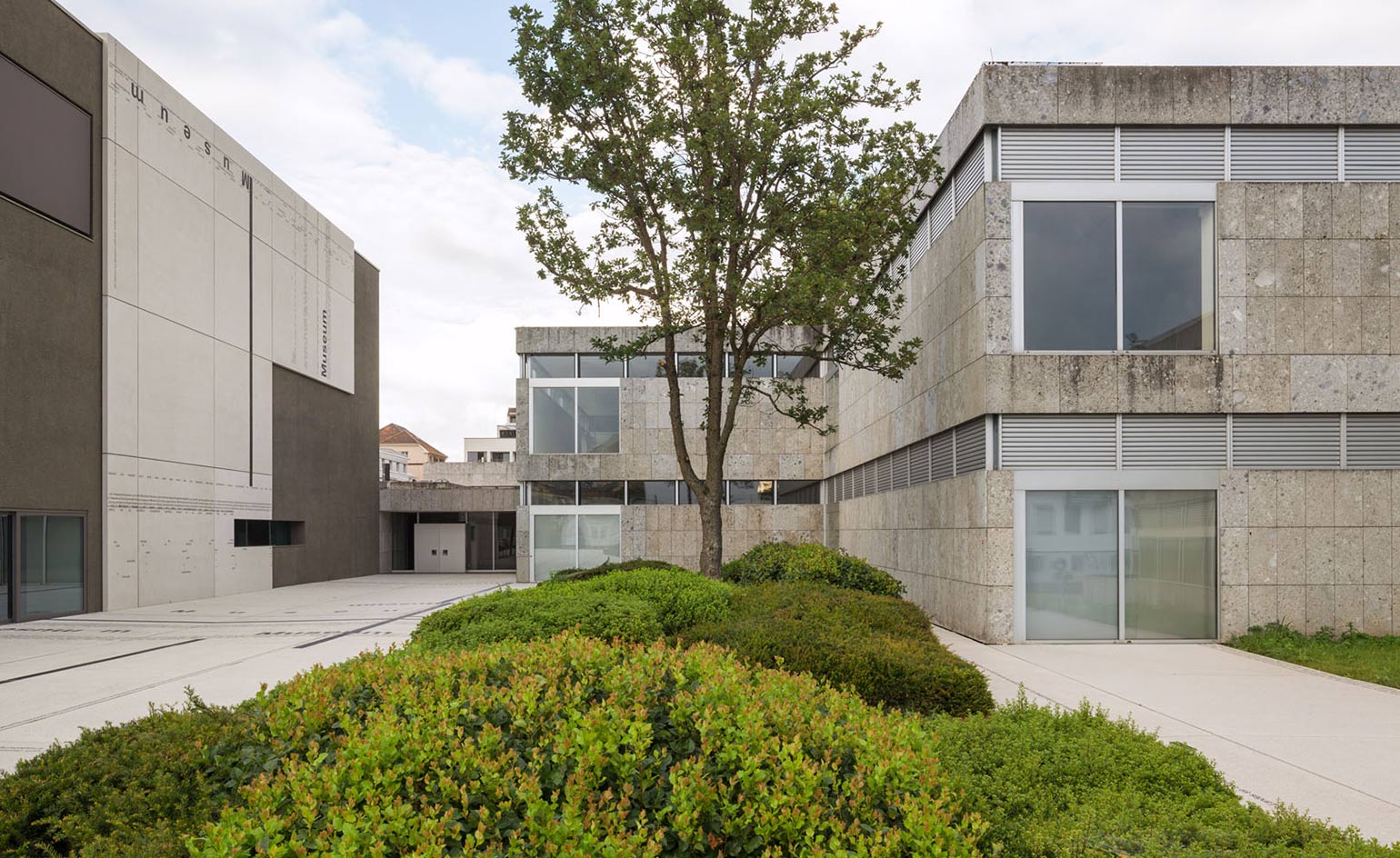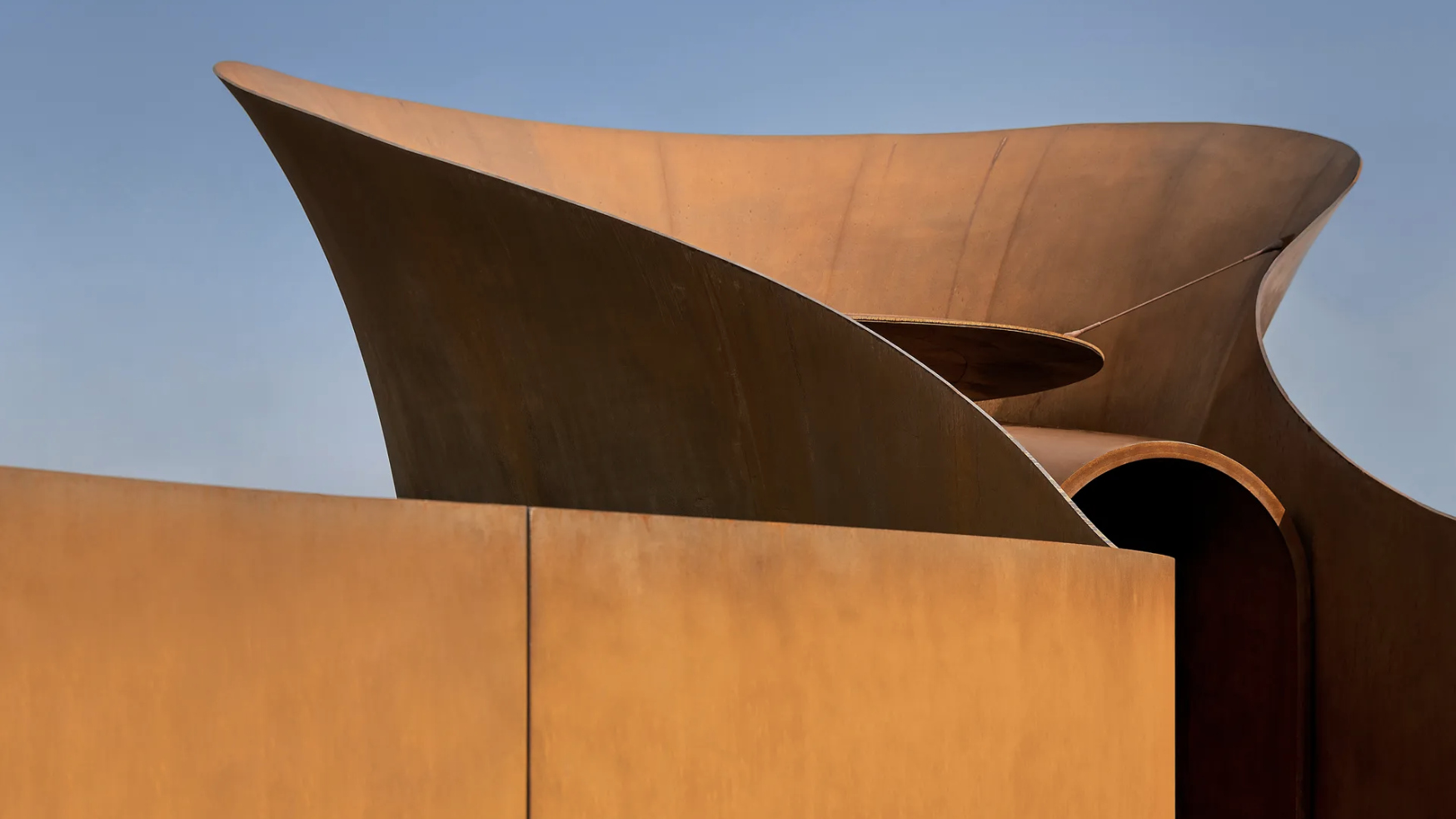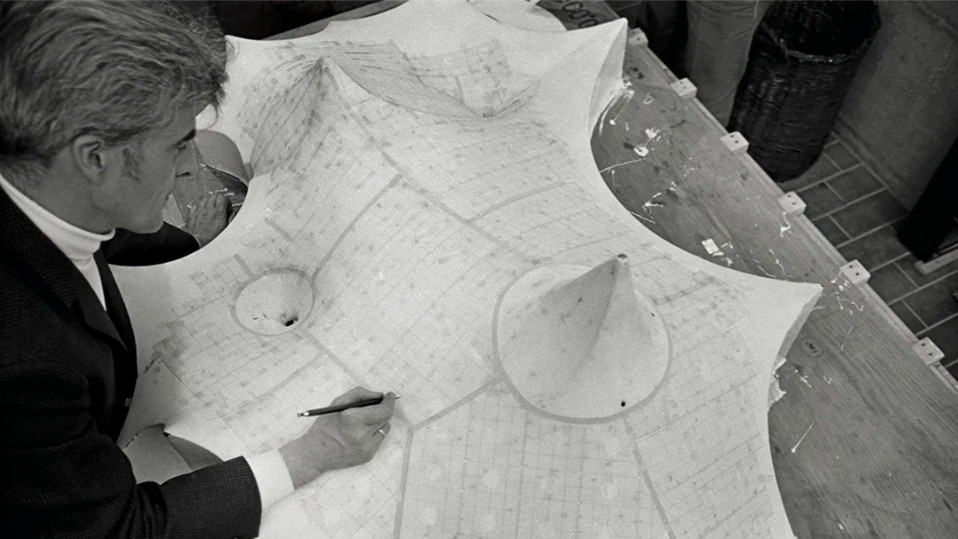Art and architecture converge at the Saarland Museum’s new extension

Some time around the 1950s, the idea of ‘per cent for art’ was introduced in Germany, whereby a percentage of a public building’s costs were to be set aside for an artwork to be displayed along the architecture. It was, and is, usually implemented by sticking a sculpture in front of a new building, or shoehorning a permanent installation into the foyer; more often than not, as an afterthought rather than integral to the artwork that is the building itself.
Berlin architects Kuehn Malvezzi don’t work like that. When they were commissioned to build a new extension to the Saarland Museum back in 2013, which opens its doors this month, they included the Frankfurt artist Michael Riedel in the design process right from the very beginning.
The main building of the Saarland Museum in Germany is a modular pavilion construction designed by Hanns Schönecker and built between 1962 and 1974 to house the region’s collection of classical and contemporary art. Despite later renovations and additions, it is still a quite lovely and little-known, horizontal, late modernist building, nestled in a sculpture garden and constructed from grey stone that looks very much like concrete with flush wooden doors and panels.
The extension for the contemporary art collection was going to be a difficult project right from the start. An earlier attempt to build an extension and new entrance building with another architect was quickly abandonded in the early 2000s leaving a half-built shell and a lot of bad feeling in its wake. Kuehn Malvezzi decided to keep the old order of the building, with its original foyer, and make the extension, just an extension. ‘Recalibrating the existing building allowed us to pay more attention to the piazza in front,’ explains partner Wilfried Kuehn.

The architects’ work features a collaboration with artist Michael Riedel. Courtesy of Kuehn Malvezzi
This is where Riedel came in. ‘We needed a process which turned everything upside down and made the political process visible, instead of making an architecture that contains and closes the process off from the visitor,’ says Kuehn. They ended up transforming the entire piazza into a kind of three-dimensional poster that you walk through and read as you are led towards the entrance. ‘The piazza also folds up vertically into the façade,’ adds Kuehn, so the whole building, piazza and artwork come together as one. The role of the architects then became about creating ‘a surface that can be written on’.
The landscaping firm Bbz Landschaftsarchitekten, who had impressed Kuehn with its design for the gardens around the contentious Humboldt Forum in Berlin, has done an impressively restrained job of fitting in around the inside out dialogue between artist, museum, public and architects.
Inside the new extension, since the entrance now remained in the main building, there is a tall, naturally-lit central space has been freed from any service functions and now dominates the building. The museum’s director Roland Mönig handed over this space to American artist Pae White and her resulting installation, a chromatic explosion of line and dimension, is an extremely striking response to the slightly austere minimalism of the building and its symbiotic artwork exterior. Kuehn loves it: ‘This is exactly how we imagined it, that someone would take over this central space and transform it completely.’ Similarly the architecture has been taken over on the outside by Riedel, ‘making it a space where art happens, rather than being just stored and shown at a distance’.
The Saarland Museum’s new extension is clearly a far cry from the days of percent-for-art afterthoughts. But is there a danger of embedded artists’ work in a building becoming too dominant, too signature? Kuehn doesn’t think so: ‘If you think of architecture as a container and art as theatre that is being played within it, then we should not involve artists in the design of buildings. If, on the other hand, we think of spatial production as a continuity, then it is the other way around. What Michael Riedel does is not so much about signature as process. I can imagine other works overlapping and juxtaposing with this work. When you are there, you can feel the balance it has with everything.’ We are inclined to agree.

The project revolved around expanding the existing stucture, which was originally designed by Hanns Schönecker and built between 1962 and 1974. courtesy Kuehn Malvezzi

The architects worked with the colour palette and the language of the existing building, using concrete and wood. courtesy Kuehn Malvezzi

The interior is a tall, naturally lit space that invites art to take over. courtesy Kuehn Malvezzi

The architects wanted to make this a space 'where art happens, rather than being just stored and shown at a distance'. courtesy Kuehn Malvezzi
INFORMATION
For more information visit the Kuehn Malvezzi website
Receive our daily digest of inspiration, escapism and design stories from around the world direct to your inbox.
-
 Discover the cool and offbeat designs of jeweller Inesa Kovalova
Discover the cool and offbeat designs of jeweller Inesa KovalovaInesa Kovalova's jewellery celebrates a mix of mediums and materials
-
 A group of friends built this California coastal home, rooted in nature and modern design
A group of friends built this California coastal home, rooted in nature and modern designNestled in the Sea Ranch community, a new coastal home, The House of Four Ecologies, is designed to be shared between friends, with each room offering expansive, intricate vistas
-
 Men’s Fashion Week A/W 2026 is almost here. Here’s what to expect
Men’s Fashion Week A/W 2026 is almost here. Here’s what to expectFrom this season’s roster of Pitti Uomo guest designers to Jonathan Anderson’s sophomore men’s collection at Dior – as well as Véronique Nichanian’s Hermès swansong – everything to look out for at Men’s Fashion Week A/W 2026
-
 Welcome to The Gingerbread City – a baked metropolis exploring the idea of urban ‘play’
Welcome to The Gingerbread City – a baked metropolis exploring the idea of urban ‘play’The Museum of Architecture’s annual exhibition challenges professionals to construct an imaginary, interactive city entirely out of gingerbread
-
 The Grand Egyptian Museum – a monumental tribute to one of humanity’s most captivating civilisations – is now complete
The Grand Egyptian Museum – a monumental tribute to one of humanity’s most captivating civilisations – is now completeDesigned by Heneghan Peng Architects, the museum stands as an architectural link between past and present on the timeless sands of Giza
-
 Doshi Retreat at the Vitra Campus is both a ‘first’ and a ‘last’ for the great Balkrishna Doshi
Doshi Retreat at the Vitra Campus is both a ‘first’ and a ‘last’ for the great Balkrishna DoshiDoshi Retreat opens at the Vitra campus, honouring the Indian modernist’s enduring legacy and joining the Swiss design company’s existing, fascinating collection of pavilions, displays and gardens
-
 A beautifully crafted concrete family house in a Mexican suburb is a contemplative oasis
A beautifully crafted concrete family house in a Mexican suburb is a contemplative oasisHW Studio have shaped a private house from raw concrete, eschewing Brutalist forms in favour of soft light, enclosed spaces and delicate geometries
-
 George Lucas’ otherworldly Los Angeles museum is almost finished. Here’s a sneak peek
George Lucas’ otherworldly Los Angeles museum is almost finished. Here’s a sneak peekArchitect Ma Yansong walks us through the design of the $1 billion Lucas Museum of Narrative Art, set to open early next year
-
 The great American museum boom
The great American museum boomNine of the world’s top ten most expensive, recently announced cultural projects are in the US. What is driving this investment, and is this statistic sustainable?
-
 A new book delves into Frei Otto’s obsession with creating ultra-light architecture
A new book delves into Frei Otto’s obsession with creating ultra-light architecture‘Frei Otto: Building with Nature’ traces the life and work of the German architect and engineer, a pioneer of high-tech design and organic structures
-
 What is Bauhaus? The 20th-century movement that defined what modern should look like
What is Bauhaus? The 20th-century movement that defined what modern should look likeWe explore Bauhaus and the 20th century architecture movement's strands, influence and different design expressions; welcome to our ultimate guide in honour of the genre's 100th anniversary this year